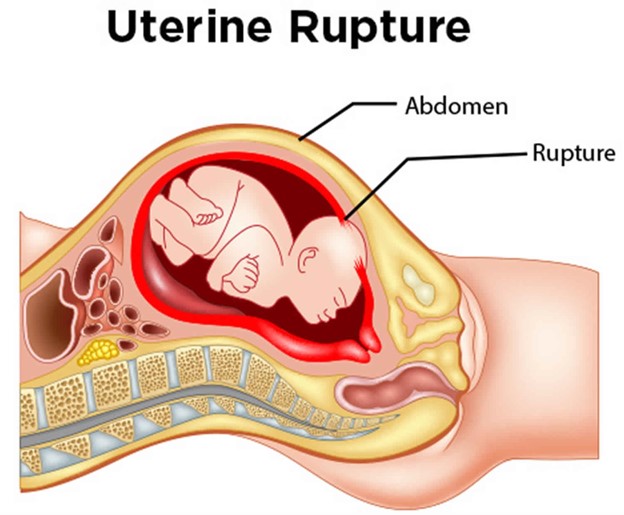A nurse is caring for a client who is in active labor and reports sudden, severe lower abdominal pain. The nurse observes a drop in the client's blood pressure and notes cool skin and pallor. The fetal heart rate tracing shows prolonged bradycardia. Which of the following complications should the nurse suspect?
Amniotic fluid embolism
Umbilical cord prolapse
Uterine rupture
Placenta previa
The Correct Answer is C
Uterine rupture. The sudden, severe lower abdominal pain, drop in blood pressure, and signs of shock such as cool skin and pallor all point to a potential intra-abdominal hemorrhage most likely due to Uterine rupture. Additionally, the prolonged bradycardia on the fetal heart rate tracing indicates that the baby may be experiencing fetal distress due to a compromised blood supply. Amniotic fluid embolism triggers an allergic reaction, causing a sudden onset of respiratory distress, hypotension, and cardiac arrest. Option D, placenta previa, occurs when the placenta implants in the lower uterine segment, partially or completely covering the cervical os. This can lead to painless vaginal bleeding but typically does not present with sudden, severe abdominal pain or signs of shock.

Nursing Test Bank
Naxlex Comprehensive Predictor Exams
Related Questions
Correct Answer is D
Explanation
A.Cranial bone overlap (molding) is common after vaginal delivery due to compression during birth. It typically resolves within a few days and does not require urgent intervention.
B.These are called milia, which are harmless and expected in newborns. They resolve spontaneously without treatment.
C.This is known as acrocyanosis, a normal finding in newborns during the first 24–48 hours of life due to immature circulation. It is not a cause for concern unless central cyanosis is present (e.g., lips or mucous membranes are blue).
D.Abnormal positioning of the ears (e.g., low-set or forward and lateral) can be a sign of congenital anomalies, particularly renal abnormalities or chromosomal syndromes such as Trisomy 21 (Down syndrome) or Trisomy 18. Because these may indicate serious underlying systemic conditions, the nurse must report this finding promptly to initiate further evaluation and possibly diagnostic testing (e.g., renal ultrasound or genetic consultation).
Correct Answer is A
Explanation
A. Apply a cap to the newborn's head: This is an appropriate intervention to conserve heat in a mildly hypothermic newborn. It is a standard practice to maintain thermal neutrality, especially in the first hours after birth.
B. Give the newborn a warm bath: Bathing is not appropriate for a newborn with a low temperature. Bathing could worsen heat loss and further lower the newborn's body temperature.
C. Reposition the newborn: While repositioning may improve comfort or support effective respiration, it does not directly address the low temperature.
D. Obtain an oxygen saturation level: The respiratory rate (50/min) and heart rate (130/min) are within the normal range for a newborn. Unless other signs of respiratory distress or cyanosis are present, this action is unnecessary.
Whether you are a student looking to ace your exams or a practicing nurse seeking to enhance your expertise , our nursing education contents will empower you with the confidence and competence to make a difference in the lives of patients and become a respected leader in the healthcare field.
Visit Naxlex, invest in your future and unlock endless possibilities with our unparalleled nursing education contents today
Report Wrong Answer on the Current Question
Do you disagree with the answer? If yes, what is your expected answer? Explain.
Kindly be descriptive with the issue you are facing.
